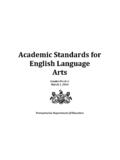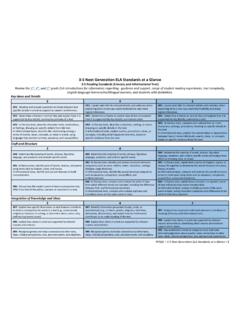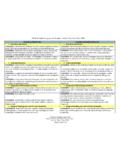Transcription of What counts as good evidence? - alliance4usefulevidence.org
1 1 what counts as good evidence ?PRovocation PaPeR FoR the aLLiance FoR useFuL evidencesandra nutley, alison Powell and huw daviesResearch Unit for Research Utilisation (RURU)School of ManagementUniversity of St AndrewsFebruary 2013 This is a paper for discussion. The authors would welcome comments, which should be emailed to: smn@st or paper presents the views of the authors and these do not necessarily reflect the views of the Alliance for Useful evidence or its constituent Alliance champions the use of evidence in social policy and practice.
2 We are an open access network of individuals from across government, universities, charities, business and local authorities in the UK and internationally. The Alliance provides a focal point for advancing the evidence agenda, developing a collective voice, whilst aiding collaboration and knowledge sharing, through debate and discussion. We are funded by the BIG Lottery Fund, the Economic and Social Research Council and Nesta. Membership is free. To sign up please visit: what counts as good evidence ?
3 41 setting the scene 52 PRactice Recommendations 83 hieRaRchies oF evidence 104 Beyond hieRaRchies? 155 stRong evidence oR good enough evidence ? 186 the use and imPact oF standaRds oF evidence and endoRsing PRactices 207 concLusions and Ways FoRWaRd 24 ReFeRences 26 annex 1 examPLes oF standaRds oF evidence schemes 28 annex 2 standaRds oF evidence deveLoPed By the sociaL ReseaRch unit at daRtington 31 annex 3 incLuding Five tyPes oF knoWLedge in systematic ReseaRch RevieWs in sociaL caRe (extRact FRom RutteR et aL.)
4 , 2010, PP 17 19) 364 what counts as good evidence ? PRovoCATIoN PAPER FoR ThE ALLIANCE FoR USEFUL EvIdENCEWhat counts as good evidence ?in briefMaking better use of evidence is essential if public services are to deliver more for less. Central to this challenge is the need for a clearer understanding about standards of evidence that can be applied to the research informing social policy. This paper reviews the extent to which it is possible to reach a workable consensus on ways of identifying and labelling evidence .
5 It does this by exploring the efforts made to date and the debates that have ensued. Throughout, the focus is on evidence that is underpinned by research, rather than other sources of evidence such as expert opinion or stakeholder setting the scene, the review and arguments are presented in five main sections:We begin by exploring practice recommendations: many bodies provide practice recommendations, but concerns remain as to what kinds of research evidence can or should underpin such labelling leads us to examine hierarchies of evidence .
6 Study design has long been used as a key marker for evidence quality, but such hierarchies of evidence raise many issues and have remained contested. Extending the hierarchies so that they also consider the quality of study conduct or the use of underpinning theory have enhanced their usefulness but have also exposed new fault lines of broadly, in beyond hierarchies, we recognise that hierarchies of evidence have seen most use in addressing the evidence for what works. As a consequence, several agencies and authors have developed more complex matrix approaches for identifying evidence quality in ways that are more closely linked to the wider range of policy or practice questions being evidence , or just good enough?
7 A further pragmatic twist is seen by the recognition that evaluative evidence is always under development. Thus it may be more helpful to think of an evidence journey from promising early findings to substantive bodies of knowledge. Finally, we turn to the uses and impacts of standards of evidence and endorsing practices. In this section we raise many questions as to the use, uptake and impacts of evidence labelling schemes, but are able to provide few definitive answers as the research here is very conclude that there is no simple answer to the question of what counts as good evidence .
8 It depends on what we want to know, for what purposes, and in what contexts we envisage that evidence being used. Thus while there is a need to debate standards of evidence we should be realistic about the extent to which such standard setting will shape complex, politicised, decision making by policymakers, service managers and local setting the sceneBackgroundCalls for the better use of rigorous evidence in developing and delivering public services in the UK are not new. They have, however, become more urgent in tone due to severe public expenditure cuts and the need to ensure that scarce funds are allocated in ever more cost effective ways.
9 The Civil Service Reform Plan (hM Government, 2012) suggests that there may be a need for an improved infrastructure to trial and assess what works in major social policy areas. The aim is to ensure that commissioners in central or local government have the evidence to support effective commissioning. There may also be a need to improve commissioning processes. A recent study of social care commissioning guides (huxley et al., 2010) found that they did not, in fact, pay much attention to research evidence (even when it was available) and relied instead on government documents or practice guidance.
10 While there are no simple infrastructure changes that are likely to transform commissioning processes, clarity about evidence will be is often viewed as being ahead of other policy domains in setting standards of evidence on which to base clinical decisions. It is therefore not surprising that there has been a lot of interest in its evidence infrastructure. In January 2012, Sir Jeremy heywood, Cabinet Secretary, held up the example of the National Institute for health and Clinical Excellence (NICE) as a possible direction of travel for the social policy field.






